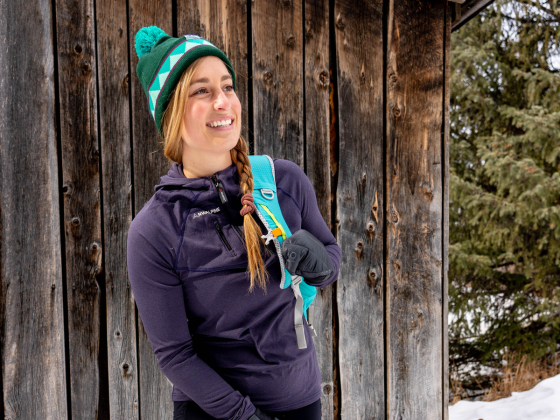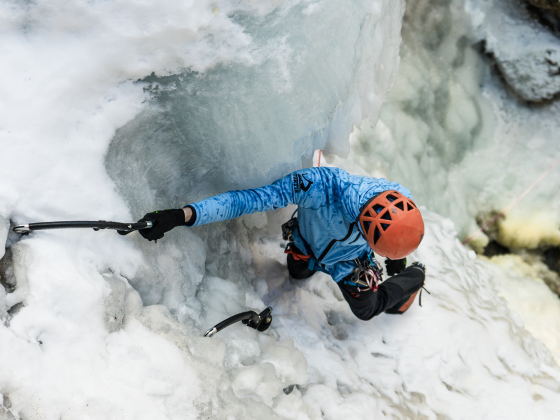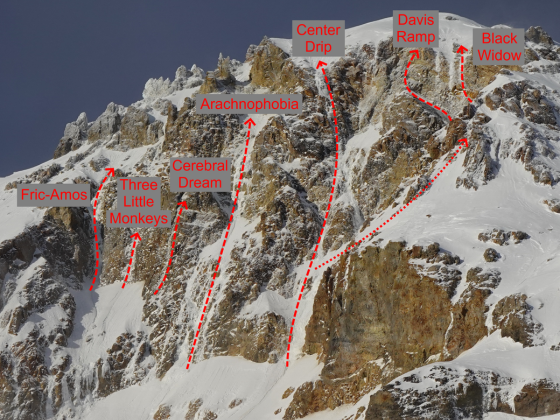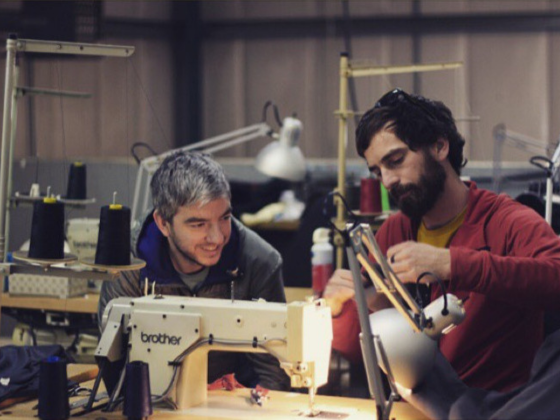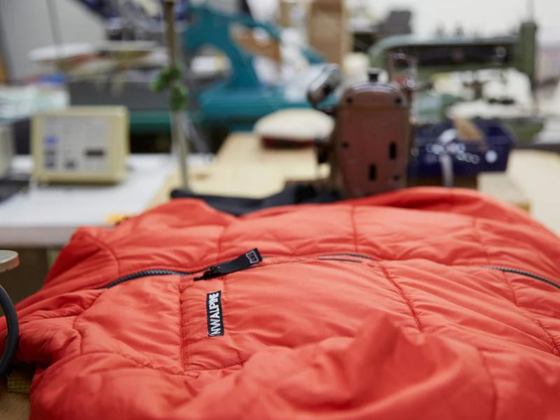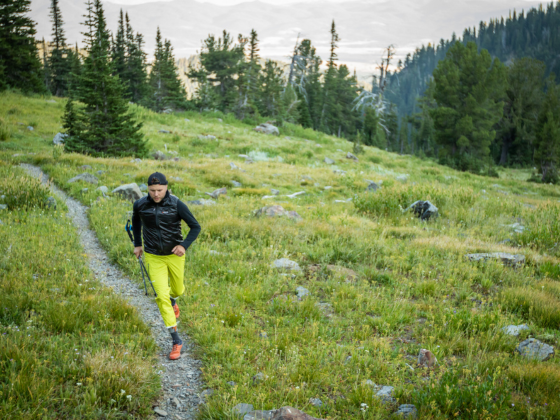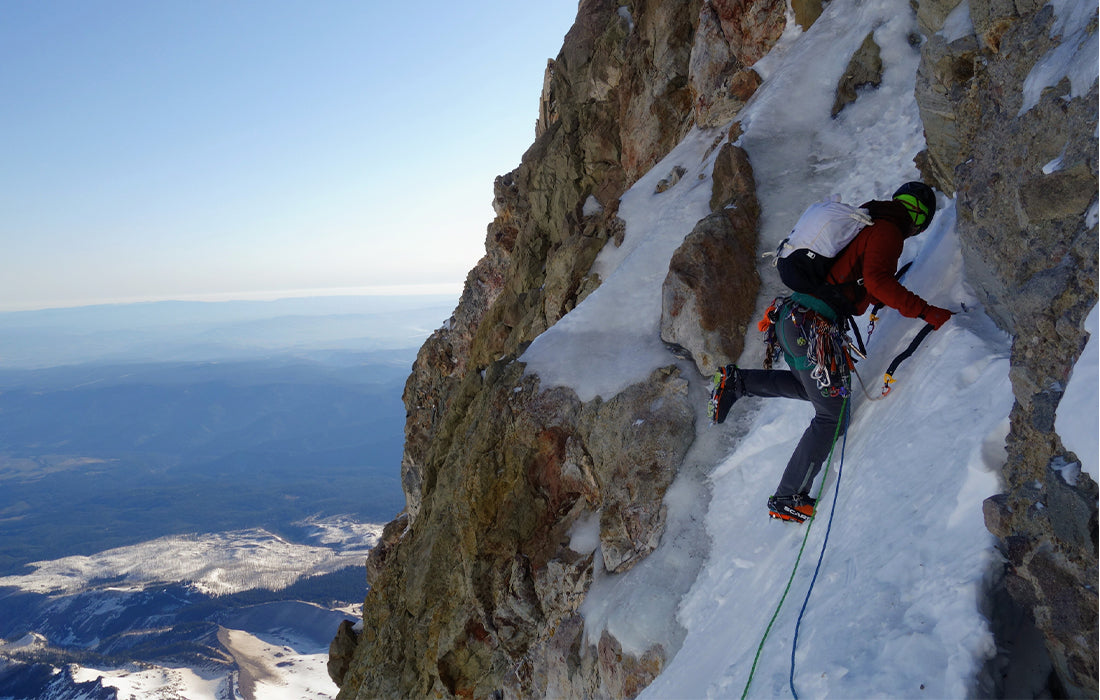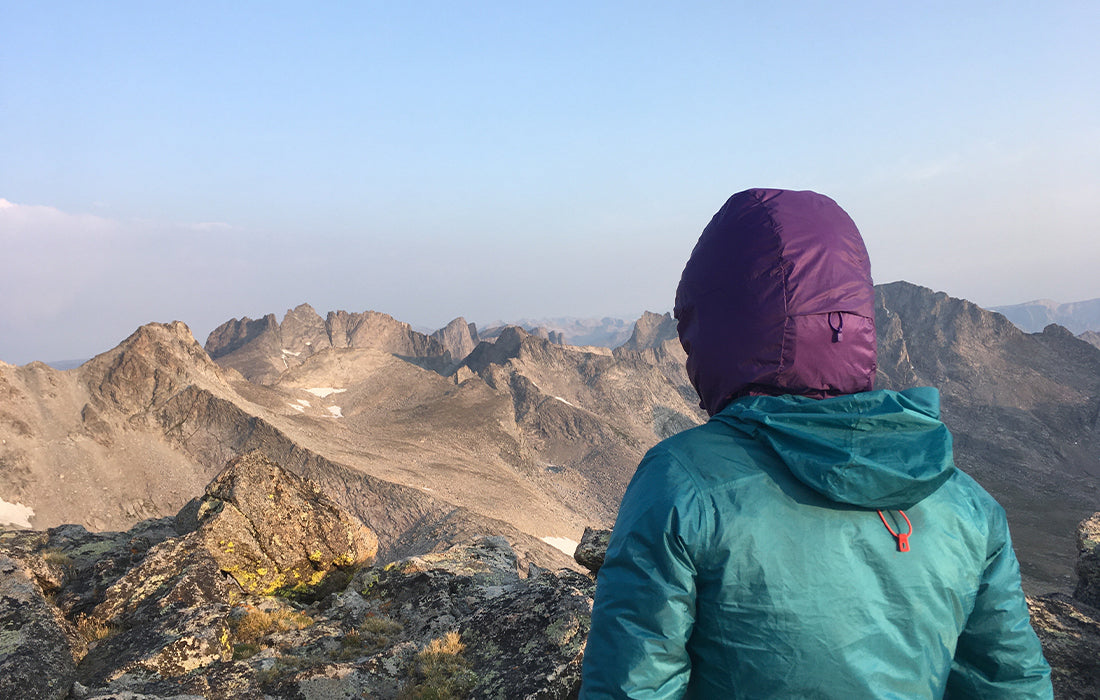Social media is chock full of pictures of people climbing, more so than ever before. The image of climbing that one gets is pretty unrealistic — where everyone is always climbing, and always climbing hard. There certainly are some people who can manage this, be it sponsored athletes or van lifers. Kudos to them, but what about the rest of us, the nine-to-fivers, or those with a family of their own? Where can we find a balance between performance and time commitment?
I asked NW Alpine ambassadors Becky Switzer and Phil Wortmann to weigh in on this topic and to provide some perspective. Both Becky and Phil climb at a very high level while juggling full time jobs and other commitments. They graciously provided some in-depth insight into their specific training plans, how they find motivation, and they offer some tips to people just getting started.
Whether you are new to climbing specific training or a seasoned climber shaving off that extra mm on your hangboard edges, this article has a little for everyone.
TRAINING SPECIFICS
Firstly, how has COVID affected your training and climbing, if at all, and what are the ways in which you are dealing with the added difficulties?
Becky: It’s not a secret that Montana is one of the least populated states in the US, so as far as closures went, my local climbing gym was only out of commission for less than three months. This was in the spring of 2020. For those months, I kept a tight group of two other female climbing partners and we climbed outside about three times a week. There’s a decent south-facing crag close to Bozeman that we frequented a lot, oftentimes not seeing any other people. I ended up climbing out the crag, but it was still a great place to get some laps, maintain sanity, and stay in climbing shape.
I’m also fairly lucky to have both a hangboard and a campus board at home. These tools are nowhere near the home gyms people have been building recently, but between climbing outside, hangboard and campus board sessions, and a couple of kettlebells, my body was happy to have a change in routine.
Phil: COVID definitely affected my training due to gym closures/limitations and social distancing. Fortunately, I already had a great system at home so this didn’t affect me as much as most folks. Another thing I did was limit the people I went cragging with, which meant being very selective of who I went out with and keeping a tight circle.
COVID associated issues aside, how do you usually organize a yearly training schedule? Do you train seasonally, in blocks, or take extended “rest” periods? Or, do you just train for specific projects or work on maintaining fitness throughout the year?
Phil: I’m a very goal-oriented person so I like to pick big, long-term goals that seem way beyond my ability and that will take me several years to attain. This also allows me to approach my projects in a very systematic, i.e. time efficient way. I break down what skills, strengths, and endurance I will need then build a schedule that fits into my life. One of the first big goals I trained for was the Leadville 100 back in 2010. At the time I decided to do it I hadn’t even ran a marathon, so that was the first “mini-goal” I set for myself. I’ve applied the same incremental training process to all of my goals since and found that it fits for anything as long as I adapt along the way to address weaknesses.
Becky: These questions really allow me to nerd out, but I’ll try not to ramble too much. I follow a very traditional sport climbing training schedule — aiming to be in peak performance shape in spring and fall. In a normal, non-pandemic year, I’ll have trips planned for both of these seasons. For the spring, I usually like to stay closer to home, traveling around Wyoming and Idaho. Fall is really my favorite time of year for hard sport climbing. Between the cooler days and the lower humidity, many of the country’s sport climbing crags are in prime condition between September and November.
Roughly, I’ll train in a 12 week cycle leading up to the March/April time period. If I get some good weather in the spring, I’ll try and redpoint some projects. Throughout the summer I’ll try and take it a little easier and dial in fall projects — basically spend as much time outside on real rock as possible. In late summer I’ll do another training cycle (usually about 8 weeks) to be ready for good temperatures in October. At times, I tweak my training for specific projects, but many times my projects will be very different in nature so it’s beneficial for me to have a well-rounded training approach.
For example, I have two projects close to home that I plan to work on this year. One is short, bouldery, and full of compression. The other project is quite long and technical, and the hardest moves for me are at the top. I enjoy both of these styles and think it’s important to have projects that challenge you in a variety of ways. We don’t become better climbers by climbing styles we are good at all the time!
Finally, December and the first part of January are times where I take it easier in regards to training. If I’m lucky, both the ice climbing and skiing will be good in Montana during these months and I’ll be out doing those activities.
I think it’s important to give yourself mental breaks from training and just “fun climb”, climb with your friends without any goals for the session, or go to the gym without an agenda. I’ve found that a couple weeks of unstructured gym time are really helpful for my mental health. Usually after a period of unstructured time, I’m itching to return to a schedule.
What is your training schedule like for a given week? Where are you training, what do you use, and how often are you actually climbing outside on rocks, on ice, or scratching rocks?
Becky: I’ve found a pretty good balance lately where I can have three hard training sessions per week. This equates to roughly 8-10 hours in the gym. I’m capable of climbing four days a week, but my expectations have to shift as my recovery struggles to keep up. From past experience, if I approach 12-15 hours of training per week, I often feel pretty wrecked and open myself to potential injuries.
As I mentioned previously, my local climbing gym has been able to stay open for most of the pandemic. Much of my climbing specific training is able to be done bouldering, and I’m lucky that my gym’s walls have a really diverse variety of angles. This keeps me sharp when dealing with gently overhanging technical terrain, but I can also switch things up and do some roof climbing if I need to refresh those skills.
My favorite hangboard to use is the one made by Tension, and if I use smaller edges for my hangs I’ve been really into the Beastmaker 8 and 10mm edges.
On top of my gym sessions, in the winter I’ll ski or ice climb two days a week, leaving me with two rest days, usually taken in the middle of the week.
When I’m trying to redpoint a climb during the warmer months, I’ll make sure I have a rest day before attempting my project. The tricky thing is, sometimes I climb better on the second consecutive day of climbing, so I have to pay close attention to how I’m feeling when I’m out projecting.
Living in Montana, the amount of outside climbing days tends to vary wildly. Some outdoor bouldering can be done in the winter, depending on one’s cold tolerance. Realistically, there’s about 7 months where the weather has the potential to be favorable.
That said, I think I easily get over 50 outdoor rock climbing days annually. The ice or mixed climbing days are a side passion and only happen if powder skiing is not in the forecast, so I’ll gather 20 more days of climbing there.
I do have a full time job (in the outdoor industry, so my boss understands the climbing obsession), so there is leeway with taking long weekends to go climb.
Phil: I train two days a week in the gym or my garage, with at least two full days of rest. I get outside only one day on the weekend and it is very specific. I go to the crag with a goal and agenda in mind, and I get it done efficiently. The style of climbs will always be similar to my project or help me address a certain weakness.

The garage wall. [Photo] Phil Wortmann
When I’m training I like to keep a pretty strict schedule. This is a random example of one week from last year’s calendar (green is the plan, yellow is my notes post-workout).

Is it all climbing specific training or do you try and do other cross training exercises? Do you do any exercise just for fun? How do you keep your training interesting?
Phil: Just about every exercise I do is specific and works toward my project at hand. This means I keep as disciplined as possible and refuse to divert energy or time to anything that doesn’t benefit. For example, the last three or four years I spent working towards a rock climbing project that was above my limit. I had many invites to take really fun trips to Alaska and Yosemite and elsewhere, but I said no because it didn’t fit my priorities. Discipline in training requires you to say “no” to fun sometimes. To keep things interesting, I change up my training slightly with different strength or endurance exercises I learn about by reading training literature (as long as it accomplishes the same goal).
Becky: My training consists of anywhere between 75/25 to 50/50 climbing/weight lifting, depending on where I am in the training cycle. The climbing aspect of training focuses on things like movement, body tension, and efficiency (to name a handful of concepts), but I also spend a fair amount of time on the hangboard and campus board.
Weight lifting has been a part of my routine since I was a college soccer player, though I have to admit lifting can become monotonous. To combat this, I’ve done two things. One is that I’ve embraced the usefulness of kettlebells. These weren’t really on the radar when I was in high school and college, but now that they’re more mainstream, I think they’re invaluable for climbers. Kettlebell swings and snatches have improved my body tension on the wall dramatically.
Another way to keep lifting interesting is to find some lifts that you want to improve on. For me this winter, it’s been the deadlift. Even though I’ve dabbled with deadlifting in the past, I took it upon myself to focus hard on technique and upping the amount of weight I could pull. When I broke the 200 lb mark a few weeks ago, I was pretty excited to accomplish this little goal. I’m curious to see how this new strength translates into power on the wall.
I keep things interesting by always including some aspect of projecting in my climbing. Whether it’s mini projects that I can do in a day or two, or a mega project that might take me a couple weeks to complete, I enjoy figuring out the puzzle of movement. I’m super selective about picking projects because if I’m not passionate about cracking the puzzle, I won’t be as motivated to come back to it day after day.
What is your recovery strategy? How do you make sure that you are getting adequate rest and nutrition?
Becky: It’s taken me a long time to figure out balance. As Westerners, I think we have tons of societal pressure to always be busy and always be doing more. When I first started training seriously for climbing, I fell into the habit of overtraining. It took years for me to realize that this was detrimental to my progress as an athlete; it took even more time to let go of the physical tendencies of overtraining.
Having proper coaching has helped me find the correct amount of training. Also, seeing the benefits of providing your body with enough rest is a huge motivator. On top of taking enough rest days, proper nutrition helps significantly with the recovery process. I’m an athlete with Gnarly Nutrition, so I’ve had access to their array of products for many years. That said, fueling workouts with plenty of carbs and then getting adequate protein immediately following a workout are the fastest ways to successful recovery.
Phil: Meal planning is essential, as well as a good sleep schedule. And, the older we get the more we have to schedule those rest days. I think 2-3 days a week of absolutely no training or exercise is essential if you want to avoid injury and fatigue.
MOTIVATION
A struggle I always have is getting motivated to train after a long day at work, especially when I am working and training all in the same place! How do you stay motivated to train after a long day at work or when you know there are other things you need to be doing as well?
Phil: This one is tough, and honestly there are days or even entire weeks when I just can’t do it. Sometimes we need the mental or physical break and we have to take it. This also helps to front load some guilt, which will make us train harder when we do get back in the gym. Another thing that has helped me is that I had to coach kids at the gym certain days, which made it harder to bail on that commitment. Also, if you can find a partner who is working on similar goals they will help hold you accountable.
Becky: The two secrets I have for this question are to train in the morning, and hire a coach. I will be the first to tell you that all I want to do after work is eat dinner and relax. I’m naturally a morning person so it is very easy for me to get up and go to the gym. My local gym is not busy at all in the morning, so I’m less likely to become distracted socializing with friends.
I’ve also had a climbing coach for the better part of the last 6-7 years — shout out to Power Company Climbing. Having a sport specific coach is one the best gifts you can give yourself as it provides accountability as well as an educated sounding board. I have quite a bit of training knowledge, but I enjoy having someone else who will take an unbiased look at my strengths, weaknesses and goals. Having a prepared outline for your workout takes so much stress out of your training routine. I believe having a climbing coach is money well spent.
As an add on to the question above: What keeps you motivated in the long run? Are you goal driven or do you just love the process?
Becky: This is such a relevant question as many folks are grappling with motivation as we come out of 2020 and launch into a new year. I believe in order to have long term success in a specific sport or passion, one has to fall in love with the process. Climbing, as with any skill sport, has an easily reachable plateau. For some people it’s climbing 5.11, maybe it’s 5.12. Regardless of where that plateau lies, to push beyond it requires a commitment to becoming the best athlete you can be.
So in the drive to become better, you can’t limit yourself with goal numbers or grades. Many times after I’ve climbed a hard route, I look back at the effort it took and say, “I can climb harder than that”. Continuing to focus on the process and putting in the work to be a better climber changes the focus from an outcome-driven motivation to a process-driven motivation. The latter being much more sustainable over time.
Any advice for people who are just getting into climbing specific training, or who recently started during quarantine as a way to stay sane?
Phil: I would say that they should pick a goal that excites them and scares them a little. There’s no way to get truly psyched and driven unless you have that project that you are absolutely obsessed with. I find that just picking a grade to work towards only leads to burn out. Pick a route or goal that calls to you on some emotional level and give all you have to it.
Becky: My two biggest tips are incredibly simple, and I can almost guarantee results if these tips are followed. The first tip was coined by Steve Bechtel, a climbing coach out of Lander, Wyoming. He said that, especially in the early stages of getting into climbing specific training, 75% of your time should be spent in climbing shoes. So when you’re going to the gym for a training session, it’s great to hangboard, campus board, lift weights, etc. But make sure around ¾ of that gym time is spent climbing, working on climbing specific drills, and practicing the art of climbing.
The final tip I’ve got is to stick with it. Persistence is really going to be the key to becoming a better climber. It matters less if you build your own training program, find a training outline online, or hire a climbing coach. If you hangboard for three weeks and then fall off the bandwagon, you didn’t give yourself a fighting chance to develop stronger fingers. If you reactivate your gym membership for the summer and go for a couple months but then take the following half a year off of climbing completely, it’ll be harder to progress as a climber. When life gets busy, even a twice a week training program can be enough to help maintain some climbing specific fitness. I see climbing and climbing training as a long game, and the investment I make now will pay dividends in the future.
LIFE
What do you like to do to just unwind?
Phil: Well, I spend way too much time sitting on my couch watching Netflix. I also have a couple beers at night to help wind down.
Becky: I’m your typical mountain dweller with an affinity for gardening and cooking good food. I also like to read (though I don’t do enough of it), and go on the occasional Netflix binge. I had an amazing German shepherd for 12 years, and now have a pint sized shelter dog, so walks and runs are daily occurrences. For 13 of the last 14 years I’ve been a dog owner and am quite religious about sharing outside time with my dog; this has equated to almost 10,000 walks over the years.
Phil, you have a son. Not to be too prying but how do you fit in work, training, climbing on the weekends, and spending time with your family? Is it hard, or not really?
Phil: This one is tough for sure, and I think having a kid should shape your goals and your training. Before I had my son, I focused on big endurance projects and took long trips. I decided that pushing myself on hard rock climbing projects was not only more practical, but was a path I had not truly explored yet. Training for strength and power takes WAY less time than endurance, and can be done right there in your own home on a hangboard or with weights in your garage. With this outlook I am able to miss very few precious moments with my boy which is the most important thing to me at this point in life.
Do you ever bring your son to the crag with you? Any tips for parents who climb on how to bring young children with them?
Phil: Some folks have success taking their kids to the crag and we’ve tried it, but my little guy is a bit too wild for that! I find it's easier to get up early and hit the crag with one friend and be back by early afternoon. Then, I spend the rest of the weekend with the family. Typically, I’ll try to get them out for a hike or scramble for a bit of extra-credit mileage.





